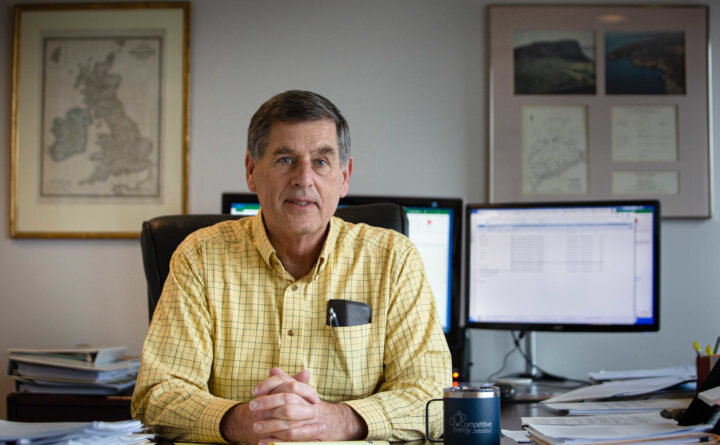
AUGUSTA, Maine — A committee clerk called it the most interesting presentation she has heard in the State House. An energy economist, Richard Silkman, has been recently distilling a 98-page plan to make Maine a zero-carbon state by 2050.It relies on a large-scale shift from fossil fuels to an expanded electricity grid powered mainly by new renewables. His main selling point? While the grid upgrades and investments in new generation and storage would cost nearly $60 billion over that period, the entire project should not cost more over time than what Mainers already regularly pay for energy.
Silkman and his research are at the confluence of issues gaining traction in Augusta. Gov. Janet Mills, a Democrat, has convened the Maine Climate Council to work toward meeting a goal to decrease emissions by 80 percent by 2050. Meanwhile, a leading Democratic lawmaker is proposing to buy out the state’s biggest utilities in favor of a consumer-owned utility.
Thorny questions underlie those proposals around spending, lifestyle changes and palatability. Silkman also faces them. But his first-of-its-kind analysis — somewhere between a thought experiment and a policy proposal — is being watched by Mills, lawmakers and environmentalists. He has presented it twice in the State House since last week.
“He has it down, and I think it will definitely be one of the discussion points of any academic segue to practical work,” said Barry Hobbins, Maine’s public advocate.
Silkman’s plan requires massive grid upgrades and a shift to electricity from fossil fuels, relying on a market phase-out of heating oil and gas-powered vehicles. Silkman, a Yale-trained economist who was director of the State Planning Office under former Republican Gov. John McKernan and now runs a Portland energy management company, pitches a proposed spending level of roughly $2 billion annually for 30 years.
This is gigantic on one hand but not the other. It would expand the grid to allow for a five-fold increase at peak demand times, but amounts to a transfer of what Mainers now spend on energy to the large-scale transition, Silkman argues. He said it could be done under the state’s existing utility structure by a new quasi-state entity to allow better borrowing rates.
It would rely on massive amounts of new renewables with the expectation that offshore wind — being tested at the University of Maine and used increasingly in Europe — comes online in 2026 and becomes the dominant power source by 2050 as solar and land-based wind become more cost-competitive.
By 2050 under Silkman’s vision, offshore wind would make up 42 percent of energy production, while solar and on-shore wind would make up 32 percent and 17 percent from negligible amounts now. His plan assumes that existing hydroelectric power will remain and does not consider tidal, geothermal or nuclear power, sources that he thinks won’t be viable politically, technically or economically.
The consumption side shows the lifestyle changes required for the shift to electricity to work. Silkman estimates that the automotive industry’s signaled shift to electric vehicles would result in those becoming a majority of passenger vehicles, buses and trucks in Maine between 2039 and 2040, while similar transitions to heating, air-conditioning and industrial processes to renewables would take longer before all sectors would reach 100 percent by 2050.
“We can’t lose sight of the fact that the transformation of the economy and our lives to get to zero emissions is quite substantial,” he said in a presentation last week to lawmakers, lobbyists and environmentalists in the State House.
Maine is going to largely replicate Silkman’s work, and there are some expected disagreements around his assumptions. His plan is largely a solo project that came after an effort from former Gov. Paul LePage to put together a long-term energy plan fizzled. He has presented to Mills and a climate council subgroup.
The council, which held its second meeting Wednesday, is going to work on a similar roadmap. Hannah Pingree, the director of Mills’ policy office, announced Wednesday the state was contracting with a company to produce cost-benefit analyses on emissions reduction, climate adaptation and inaction that will inform a four-year climate action plan due in December.
It will be broader than Silkman’s energy sector-focused work, but any climate and energy plan is almost assuredly going to head in this direction given the state’s goals. Pingree said Silkman’s work was “bold and grounded in a lot of data analysis, which is helpful.”
There are still unanswered questions about the council’s work. Mills’ emission reduction goal is more ambitious than her pledge to the United Nations that Maine will be carbon-neutral by 2045, since research led by the University of Maine based on 2007 and 2016 data found forests offset 55 percent of Maine emissions, or 75 percent with forest products included in the calculation.
Proposed solutions are also likely subject to debates about short-term costs and long-term investments. At a Silkman’s presentation last Thursday over a lunch hour in the State House, Rep. Diane Denk, D-Kennebunk, noted there were no Republican lawmakers in the room.
Rep. Steven Foster, R-Dexter, a member of the Legislature’s energy committee, which Silkman presented to last week, said such a path would be a “huge undertaking.” He said other methods, including nuclear, could be considered and he wondered whether markets will shift enough to allow the required shifts — including the one to electric vehicles — without public aid.
Ken Colburn of the Regulatory Assistance Project, which advises energy and emissions regulators in the world’s largest energy markets and co-chairs a climate council subgroup, said advances in technology and energy efficiency could allow Maine to meet the 100 percent goal faster than Silkman proposes, but he said the economist showed “it’s doable.”
“All it requires is dedication and effort,” he said.
Article By Michael Shepherd, BDN Staff
Click Here for the full Bangor Daily News article.
